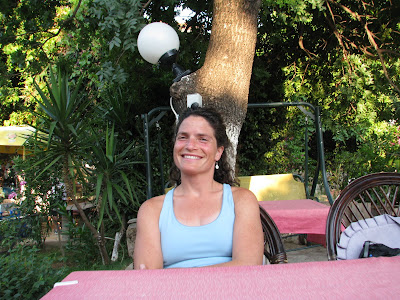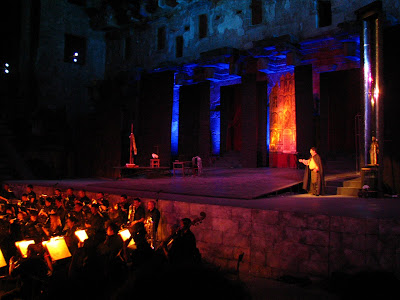
The second leg of Randy's and my Turkish adventure included a 4-day backpacking trip along the Lycian Way, or Lykian Yolu as it's known in Turkish. The entire Lycian Way is over 500-km. long and takes a month to complete, but as Randy and I had limited time and were attempting this in off-season (we were the only ones on the trail because it's so hot in July), we opted to do the first stretch of 55km starting in Ovacik, near Oludeniz, and heading east.
The Lycians were a pre-Hittite people that occupied this mountainous region of the Turquoise Coast between Fethiye and Antalya. They were famous for their fierce desire for independence. On two separate occasions the Lycian citizens of Xanthos built a funeral pyre and burnt themselves alive so as to avoid being conquered. They had their own language and customs, for instance figuring their heritage by their mother's side and not their father's lineage. The Lycian cities organized themselves against external authority as the Lycian Federation, a democratic grouping of voting units, electing national and municipal authorities until the control of Lycia was assumed by Rome. The Lycians are first mentioned in writing in Homer's
Iliad, in which they fought as allies of the Trojans. Persian and Athenian domination of the region began in the 6th century BC, and by the 3rd century BC the Lycian's native language was replaced by Greek. By 43 AD, the region was joined to a larger Roman province. Most of the ruins seen along the trail are Byzantine and Roman.
Other than a couple side treks down valleys to the beach, our entire trek had views of the ocean from high up mountainsides, and a seabreeze kept us going in the hot temperatures.







We spent our first night in Faralya. The entire town was perched on a cliffside, making open land hard to find for camping. A nice lady who owned a market offered us her garden to camp in; in exchange, we had breakfast at her market the next morning.



We began the second day with a brief day hike down into the famous Butterfly Valley. We had initially been disappointed on the Blue Cruise that we didn't get to visit this valley, but after seeing the Valley from above and dropping into it via ropes and a steep path, we agreed seeing it this way was much more stunning.
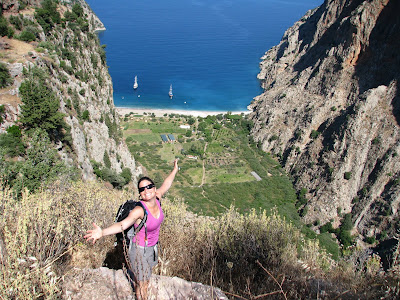








The second night we stayed in Kabak Vadesi (Squash Valley). We hiked down to the beach for a swim and to cook dinner.
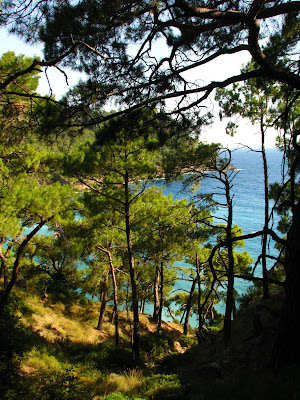


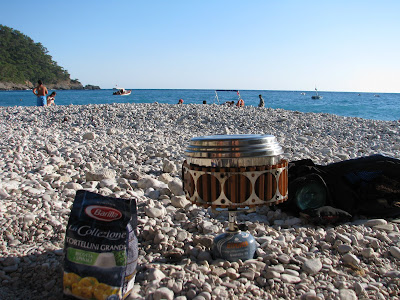

We found a pension in town offering camping, but since the place was so empty, the owner, Fatih, offered this raised wooden platform with a view of the sea and the mountains as our bed. Under the stars with a glass of wine to boot. It was slowly becoming clear by the number of villages along the way that this so-called "backpacking" trip could have easily been a series of connected day hikes, and that we didn't need to be carrying our homes on our backs. We were even able to "bath" in the pool before and after bed. (Sorry about that layer of scum we left behind, Fatih.)



We came across these old gravestones in a forest along the trail the next day.


Our last day and night were the most wild and uninhabited. We hiked past the small town of Alinca. Since water had been more scarce on this day, we were glad to have gotten water from a nice family in Alinca. And we actually camped outside of town, making the backpacks we lugged the last 50 km. totally worth it!



On our hike out the next morning, we past the most impressive of our ruin sightings: an Ottoman cistern.





I highly recommend this beautiful long distance trail to anyone living in or visiting Turkey, especially in the months of April or May. If you want to make it an easier vacation, each town with its pensions is only 10-15 km. from each other, so you could just hike with a little day pack. This is such a beautiful part of the country!
Showered and ready for a meal and a soft bed in Antalya:

